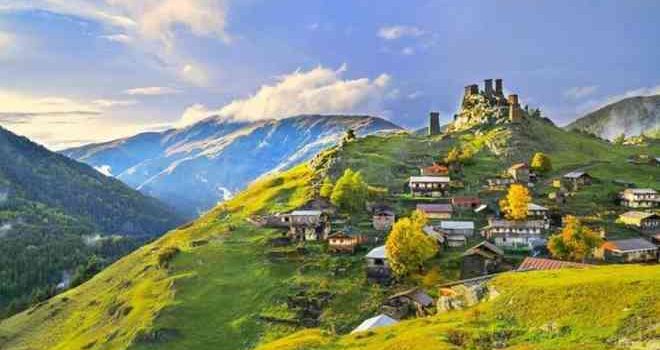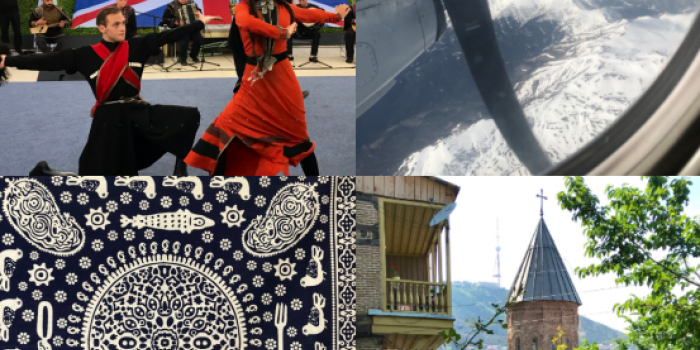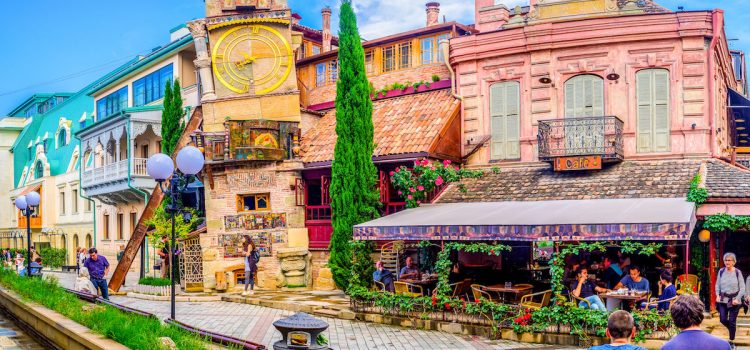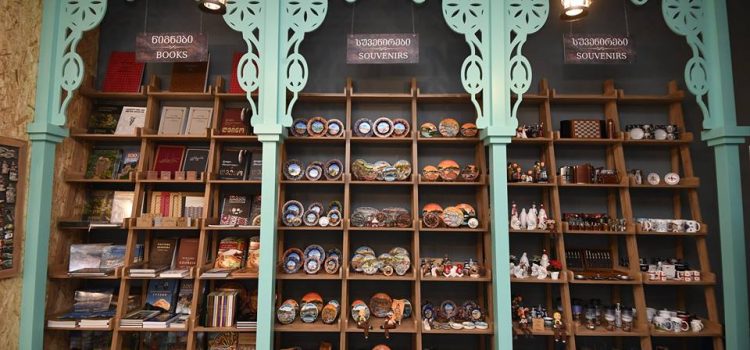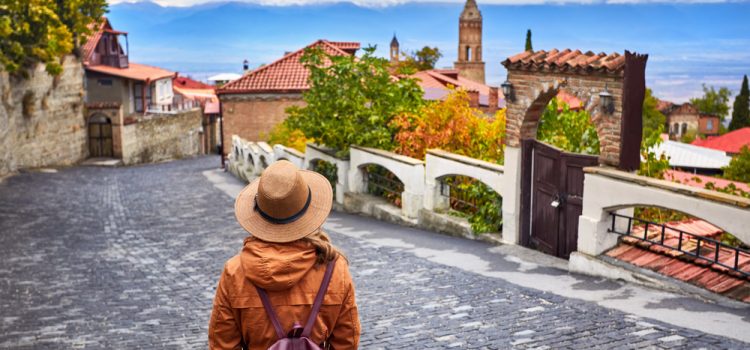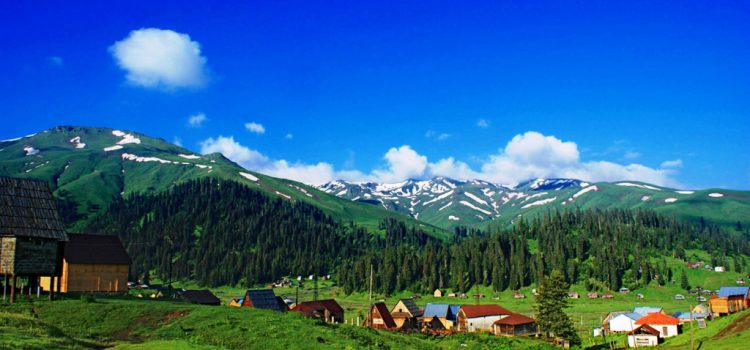The Daily Beast about Tusheti: The Last Wild Place in Europe
The Daily Beast has recently published an article about Tusheti, a historic region in northeast Georgia. Benjamin Kemper, the author of the article claims that the venue is the last wild place in Europe. He had visited Georgia many times but Tusheti had always been out of reach. The road to Tusheti is one of the most dangerous drives in the world.
“Even at the height of summer, it takes six hours of nauseous off-roading from the nearest town to reach the first Tushetian hamlets, and once you’ve arrived, you can all but forget creature comforts like cell service, internet, ATMs, and heat. But I was sold: The promise of an off-the-grid adventure in one of the last truly wild corners of Europe was too enticing to pass up,” reads the article about Tusheti.
The intact nature of Tusheti awaits visitors. The area is inhabited by “mountain goats, imperial eagles, brown bears, and, if you’re lucky, rare indigenous species like the Caucasian black grouse and East Caucasian tur, a goat-antelope with horns so enormous they look like they belong on a triceratops. There are even occasional, if uncorroborated, Persian leopard sightings.”
A herd of animals is moving forward on rocky slopes of the Great Caucasus Mountain and the scene can be observed from almost any place in Tusheti. The centuries-old towers will amaze visitors by their greatness and long-standing history. The towers used to be refuges protecting the locals from invaders or fatal avalanches.
“Medieval Tushetians did not mess around—they had their freedom to protect. From the earliest written records until well into to the 17th century, they enjoyed virtual autonomy as a tribal democracy. Although Tushetians coexisted fairly peacefully through the centuries with neighboring tribes such as the Chechens, Khevsurs, Lesghians, and Hinukhs, and traded often with them, they remained culturally distinct with their animist deities, transhumant lifestyle, fast-footed dances, and twangy dialect,” reads the article about the history of Tusheti.
Upon the hills, one can find a cluster of shrines called khatebi that is allegedly dedicated to Pagan-Christian demigods. Meanwhile, visiting a family in Tusheti will definitely involve tasting the traditional lamb-stuffed khinkali (Georgian dumpling).
Interested in the future of the region, Nugzar Idoidze, one of the locals of the village Omalo in Tusheti cheers the author up by saying that since Tushetians survived the Soviet pressure, they can survive anything.
The Daily Beast is an American news and opinion website focused on politics and pop culture.
source: www.Georgianjournal.ge
A few things why you should visit Georgia by British Ambassador
Justin McKenzie Smith, a British ambassador to Georgia has recently posted photos of Georgia on Twitter with the caption: “These are a few of my favorite things. #VisitGeorgia #WorldWelcomeToGeorgia #SpendSummerInGeorgia”. The photos reflect Georgian traditional dances, Old Tbilisi, Looking over Georgian mountains from an airplane and Georgian blue tablecloth.
The campaign ‘Spend Your Summer in Georgia’ has been launched by Georgian activists together with businessmen and international society in response to the ban on Russian airlines from carrying Russian citizens to Georgia from July 8. The campaign aims at popularizing Georgia as a travel destination to tackle the possible difficulties due to the decreased number of incoming Russian tourists. Besides, Russian tourists have encouraged their Georgian friends by saying that they will find other ways to reach Georgia.
The ban was followed by the cancellation of the Inter-Parliamentary Assembly on Orthodoxy. The assembly was led by the President of the Inter-Parliamentary Assembly on Orthodoxy, Sergei Gavrilov, a deputy of the Russian Duma from the Communist Party. Angered by the presence of Sergei Gavrilov in Georgia, citizens gathered at the Parliament building in Tbilisi to protest Russian occupation in Georgia.
Source: www.Georgianjournal.ge, Photo: www.Georgianjournal.ge
What Georgian Pirosmani and Spanish Picasso have in common
Niko Pirosmani was a Georgian primitivist painter. The paintings of Niko Pirosmani were not presented at museums but at inns, taverns, shops, etc. Throughout his life, Pirosmani was poor taking ordinary jobs including housepainting and whitewashing buildings. He also worked for shopkeepers in Tbilisi, creating signboards, paintings, and portraits, according to their commissions.
He usually painted on oilcloth. There are many works about merchants, shopkeepers, workmen, and noblemen groups. Pirosmani was fond of nature and rural life. He rarely painted city. He made many animal paintings. He was the only Georgian animalist. Pirosmani also was attracted by historical figures and themes such as Shota Rustaveli, Queen Tamar, Giorgi Saakadze, as well as ordinary Georgian people and their everyday lives.
Pablo Picasso grew up in a poor family. His father, a provincial drawing teacher who was training him, discovered the talent of Picasso at a very young age. After some sessions of art school in Barcelona and Madrid, Picasso spent his adolescence associating with the group of Catalan modernists who gathered at Els Quatre Gats in Barcelona. Later he moved to Paris where his work began to attract serious critical attention and praise by the time he was twenty. The greatest contribution of Pablo Picasso to art is the invention of Cubism that secured his immortality.
Surprisingly enough, Pablo Picasso created a graphic portrait of the Georgian painter Niko Pirosmani in 1972. However, the two never met each other. It was Ilia Zdanevich, a Polish immigrant, who showed a catalog of Pirosmani’s works to Pablo Picasso. Ilia Zdanevich left the Soviet Union in the 1930s because he could not conform to the regime and took a catalog of Pirosmani’s works with him. When Ilia became acquainted with Pablo Picasso, he showed this catalog to him. Picasso was so impressed by the paintings that he decided to create a portrait of Niko.
Source: www.Georgianjournal.ge, Photo: www.Georgianjournal.ge
Campaign ‘Spend Your Summer in Georgia’
Russian President Vladimir Putin has signed a decree prohibiting Russian airlines from carrying Russian citizens to Georgia from July 8. Putin has ordered the Cabinet of Ministers to help the citizens of Russia, who are traveling to Georgia, to return to Russia. Moreover, some recommendations have been issued for Russian tour operators, calling on them to refrain from selling tours in Georgia.
Subsequently, Russian airlines will stop selling air tickets to Georgia from July 8. According to Russian media, Smart, Pabeda, Red Drive and S 7 have already stopped selling tickets.
In response to the ban and the possible threats to the Georgian tourism industry, Georgian activists together with businessmen and international society have launched the campaign ‘Spend Your Summer in Georgia’. The campaign aims at popularizing Georgia as a travel destination to tackle the possible difficulties due to the decreased number of incoming Russian tourists. Besides, Russian tourists have encouraged their Georgian friends by saying that they will find other ways to reach Georgia.
Georgian airline companies are also launching Russia-Armenia-Georgia flights to help Russian tourists enter Georgia. Georgian businessman Mamuka Khazaradze is ready to cover 10 flights for Ukrainian tourists to support the Georgian tourism industry. Every day local as well as international support is getting stronger and stronger.
The ban was followed by the cancellation of the Inter-Parliamentary Assembly on Orthodoxy. The assembly was led by the President of the Inter-Parliamentary Assembly on Orthodoxy, Sergei Gavrilov, a deputy of the Russian Duma from the Communist Party. Angered by the presence of Sergei Gavrilov in Georgia, citizens gathered at the Parliament building in Tbilisi to protest Russian occupation in Georgia.
Source: www.Georgianjournal.ge
Georgian restaurant ‘Natali’ in Spain
There are more and more Georgian restaurants appearing abroad. While the locals in foreign countries enjoy Georgian cuisine, Georgian restaurants usually serve as a gathering place for Georgina emigrants.
Otar Loliashvili along with his wife have been living in Spain for about 10 years. Two years ago, they opened a Georgian restaurant ‘Natali’. The restaurant is located near Valencia and has already become a popular place. According to the owner, the locals especially love Mtsvadi (grilled meat skewers), Adjarian da Megruli Khachapuri (Georgian cheese bread). Otar Loliashvili says that as it is impossible to find cheese for Khachapuri in Spain, they have to produce it by themselves.
Besides, ‘Natali’ is a meeting point for Georgian emigrants in Spain. It has become the emigrants’ tradition to gather and have fun together in the restaurant. According to Loliashvili, they did not face any obstacle while starting a business in Spain. They only had to have the necessary documents in order. He says that the only challenge in Spain is high taxes and prices for products. However, their restaurant is cheaper than other restaurants in the country.
Source: www.Georgianjournal.ge, Photo:Georgianjournal.ge
Georgian – shop for tourists
The largest book shop in Georgia ,,Biblusi’’ has opened the first shop specially designated to the needs and interests of tourists and named it ,,Georgian’’. Shop Georgian is located on the David Aghmashenebeli 55. ,,Georgian’’ is unique of its kind and offers variety of the Georgian products to tourists.
Visitors of the shop ,,Georgian’’ can obtain high quality products made by the Georgian entrepreneurs. There is variety of products and the place is very interesting among tourists.
Representatives of Biblusi emphasize that by making this step they want to encourage the Georgian entrepreneurship as well. Shop ,,Georgian’’ cooperates with them and contributes in popularization of the Georgian products. This is very important to spread the Georgian products on the foreign markets.
Tbilisi Mayor: “Orbeliani Square to be one of Tbilisi’s most beautiful areas”
“Orbeliani Square will be one of Tbilisi’s most beautiful areas”, promises Mayor of Georgia’s capital Kakha Kaladze, who visited the construction site today to inspect how the rehabilitation works are undergoing.
Currently, two buildings are being dismantled on Orbeliani Square, where later a new one will be built.
Meanwhile, construction rehabilitation has finished on Mtkvari and Virsaladze streets where underground communications were arranged and also a new cover of asphalt was laid.
The rapid and major transformation of Orbeliani Square started in December of last year. This is the second state of the New Tiflis project, which launched in 2016 when the Government of Georgia renovated 45 addresses on Aghmashenebeli Avenue in the Marjanishvili neighborhood.
This time, the rehabilitation site covers Atoneli, Virsaladze, Pkhovi, Treasury, Bridge, Purtseladze and Tabukashvili Streets, where the rehabilitation of underground engineering communications’ systems is underway. In total 18 buildings will be rehabilitated of which 13 are historical buildings.
The first stage of the project includes the renewal of drainage, wastewater, sewage and water supply systems as well as the refurbishment of gas and electric supply systems.
The next stage of the project includes the restoration-rehabilitation of buildings and the construction of an underground parking lot, which will commence after all underground engineering communications’ systems will have been rehabilitated.
The rehabilitation of Grigol Orbeliani Square and its adjacent areas will cost about 55 million GEL in total and is due to be finished by the end of 2018.
source: www.agenda.ge
Georgia’s Historic Gem: Sighnaghi, The City of Love
Sighnaghi is a charming little town to the east of Tbilisi, located at an altitude of 740 meters above sea level. The town offers scenic views of the Alazani Valley and the Great Caucasian ridge, but not only this: Sighnaghi and its surroundings are being developed rapidly with more and more attractions popping up by the year.
When I first went to Sighnaghi in 2010, the town was already in the process of being restored. But even back then, a visit to Sighnaghi was a great experience in itself, taking into account its great historic wall, Sighnaghi National Museum, which houses a number of great masterpieces of Niko Pirosmani, and the town’s location close to the famous pilgrims’ destination, the Bodbe Monastery.
In 2010, Sighnaghi, in terms of infrastructure, didn’t have much to offer visitors aside from its great panoramic views and a few newly refurbished central streets. It had a few restaurants, one hotel and a couple of guesthouses. The rest of the town, with its crumbling facades, rusty roofs and pot-holed roads, reminded one heavily of a Potemkin village.
Since then, many things have changed. The city’s appearance, its roads, facades, and infrastructure have been restored or renovated; and throughout the town numerous restaurants and guesthouses have been established. Tourists from all over the world, including China, South Korea and Japan, now stream to Sighnaghi, meaning you’ll be hard put to find a household there which is not somehow involved in the tourism business.
“When I registered my guesthouse in the Booking.com system three years ago, I was the 34th on the list of Sighnaghi accomodation,” said Roman Beghashvili, a Sighnaghi guesthouse owner. “Now, there are around 150 on the list.”
Competition drives those in tourism to make their places more attractive to tourists. The ideas vary and are sometimes rather eccentric. There are plenty of picturesque cafés and hotels built beside the historic Sighnaghi wall. One of them, for instance, located on high stilts, seems to be hovering over the town, and offers guests the chance to take a paraglider flight or enjoy a drink overlooking the Alazani Valley and the historic wall, which is more than 4 km long. I’ve only had one comparable view of a medieval wall, and that was in the historic city of Avila in Spain.
“The first reminiscences of our town wall were found in chronicles of the 13th century,” said Mariam Guliashvili, the town historian. “But the construction of the wall which you can see now was ordered in the 18th century by King Irakli II. Our enemies used to attack our villages in the Alazani Valley: from the north came the Lezgins, from the south the Persians. They stole our women, children and livestock in order to sell them into slavery. To protect the inhabitants of the valley from the intruders, King Irakli II gave the order to construct this wall, which according to different documents was between 5 and 7 km long and had 23 towers and eight gates. Now we have over 4.5 km of it left, which comes close to the Small Wall of China with its 5 km length.”
Sighnaghi received its “city” status in 1770. At that time, it was already a vivid town of workmanship and trade with a population of up to 10,000 people, the majority being of Armenian origin. The King had ordered the Armenians to settle in Sighnaghi, as the Alazani Valley had previously been devastated by Shah Abbas, who took 100,000 Georgians to Persia.
In the following centuries, Sighnaghi became a great cultural and educational center, with its own theater and schools. Girls were educated in private schools established in the houses of rich citizens. In Soviet times, Sighnaghi was a flourishing tourist attraction with a big hotel located close to the town. The town was proud of its own Ethnographic Park, where archeologists from all over the country worked together on excavations. You still can visit this area now, if you take a walk in the beautiful and newly restored town park, which is romantically located on the slopes of Sighnaghi, behind the wall. Also worth a visit is the local cemetery, bearing many exciting stories of past times. With a little imagination, you can see the town history right there.
In order to inquire about recent tendencies in tourism, I headed to the Sighnaghi Information Center. The officer, Zurab Siprashvili, told me that just 10% of those who come to Sighnaghi actually visit the Information Center. He put the number of tourists that visited Sighnaghi last year at around 11,000 people, with the trend growing by the year. Most of the tourists come from Russia, Poland, Germany, France and Israel.
Sighnaghi’s location on a hill high above the ancient winemaking valley contributes to its increasing popularity. There are four big wineries as well as many wine degustation points in Sighnaghi.
From the town’s Deputy Mayor, Madonna Batiashvili, I learned about further plans concerning tourism and further development of the Sighnaghi region. “In future, we want our guests to stay longer in our region, so we plan to develop the nearby villages of Tsnori and Machkhaani. The latter is a unique village with an old theater from the 19th century and many historic houses, which are quite different from the usual Kakhetian houses. Machkhaani will soon be given the status of a Museum Village,” Batiashvili noted.
The town council plans to establish a new tourist route connecting Sighnaghi, Tsnori, Machkhaani and proceeding to Dedoplitskharo, a city with its own Pirosmani museum. Investments should be made in agricultural tourism for those visitors who enjoy nature, hunting and fishing, and who want to learn more about making churchkhela and baking Georgian bread. Several cable car routes should be established in order to connect some villages and allow visitors to enjoy great views of the Alazani Valley.
What else makes Sighnaghi so attractive for tourists? One of the town’s most renowned attractions is a quick marriage in the Marriage House, which operates 24/7.
“All you need is your passport and two witnesses,” Batiashvili told us. “Just imagine: I recently met a couple who became husband and wife early in the morning, at 4 am!”
Indeed, getting married is easy in Sighnaghi, as you don’t need to deal with bureaucracy at all. “Many of our citizens have become witnesses already, and they are now treated as relatives by the families of the newly married couples,” Batiashvili proudly said.
Source: www.Georgiatoday.ge; By Tatiana Montik
Bakhmaro – Unique resort with healing properties
Bakhmaro located in Guria (western Georgia) is one of the healthiest resorts of the country. It lies on the Bakhvistsqali River. Bakhmaro is distinguished by the combination of alpine and marine climate. It is situated 1950-2050 meters above sea level. This is the highest alpine climate resort in Georgia. The resort abounds with spruce, pine and fir trees.
All the mentioned features make Bakhmaro a magical place for many people with health problems especially those with lymph, respiratory diseases and anemia. Besides its heavenly landscape, beautiful pine forests, alpine meadows and amazing views the area are notable for its small cute cottages that are scattered throughout the green valleys with a river flowing through them.
It is believed that visiting Bakhmaro will make your immune system stronger. Its clean and transparent air speeds recovery from illness. Two centuries ago a shepherd diagnosed with tuberculosis visited the area (before the resort was discovered and named) and recovered from the disease. At that time, people thought it was a miracle but later the unique properties of the area were discovered and it was named the resort Bakhmaro.
Source: www.Georgianjournal.ge

